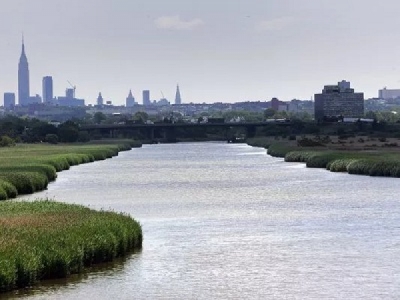
Posted on May 3, 2018
By James M. O'Neill, NorthJersey.com
To reduce the human health risk from high levels of mercury, PCBs and chromium in the Meadowlands, the federal government announced Monday a $332 million plan to dredge about 100 acres of waterways and marshland in Berry’s Creek, a key tributary of the Hackensack River that encircles MetLife Stadium.
Mercury levels in Berry’s Creek, which runs for 6 miles through six Bergen County towns, are among the highest ever recorded in a freshwater ecosystem in the United States.
The proposal comes after seven years of study and research by the federal Environmental Protection Agency, and would address the upper two-thirds of the creek, north of Route 3.
“The actions proposed today will mean that we get to the worst pollution in this area first, while we continue to assess what other actions might be needed in the future,” said Pete Lopez, the EPA’s regional administrator for New Jersey. “We know these heavily contaminated areas are contributing to environmental degradation in the Meadowlands, and if we can address these, we will go a long way toward addressing contamination throughout the Berry’s Creek area.”
The cleanup will involve dredging down about 2 feet along nearly 88 acres of the creek’s channels and a foot deep throughout about 28 acres of a marshland near Paterson Plank Road called Upper Peach Island Creek, and then installing clean fill over the dredged area.
One small section around a set of radio towers will get a cap and will not be dredged, EPA officials said.
EPA officials are concerned about people who go crabbing in the Berry’s Creek area, because mercury in the sediment can change into methylmercury, a form that builds up in the tissue of fish and crabs. It can affect the human nervous system and cause impaired vision, motor-skill damage, seizures and even death.
“It’s a very good step in the right direction,” said Bill Sheehan, the Hackensack Riverkeeper. “The Berry’s Creek area has the worst mercury poisoning around.”
Other environmental advocates were less enthusiastic.
“It’s good they’re coming up with an interim plan, but we’re concerned that caps will fail,” said Jeff Tittel, who heads the New Jersey Sierra Club. “Under the cap will still be millions of cubic yards of toxic sediment in an area with constant flows from the creek and tidal influences. Caps in these kinds of areas will fail eventually.
“It’s an area where sea level rise and storm surge will have a big impact,” Tittel said. “Another Superstorm Sandy could rip that cap open.”
The EPA wants to clean up this portion of the creek because the contamination remains in the top layer of sediment and poses a risk to both humans and the ecosystems’ aquatic life.
A tide gate installed across the creek has prevented newer, clean sediment from being deposited over the contamination along that part of the creekbed, EPA officials said.
The EPA wants to clean up this portion of the creek because the contamination remains in the top layer of sediment and poses a risk to both humans and the ecosystems’ aquatic life.
After dredging, the EPA will install a clean layer of fill, but only to the level that was removed, and not higher, to avoid causing any flooding issues for the neighboring towns, officials said.
The EPA is holding a session to explain the project and gather public comment on May 9 at 6:30 p.m. at the Little Ferry Public Library. Written comments will be accepted by the agency until June 6.
After reviewing and responding to comments, the agency hopes to sign off on the project by Sept. 30.
It will then take two years to design the dredging project and more than three years to carry it out.
Berry’s Creek starts near Teterboro Airport and twists around MetLife Stadium and the Giants’ training facility. It flows through parts of Teterboro, Wood-Ridge, Lyndhurst, Carlstadt, Rutherford and East Rutherford.
The creek serves as a prime breeding ground for crabs, fish and other species, as well as a key stopover site for migrating birds — a green, watery oasis amid the most densely developed region in America.
But for decades, Berry’s Creek has been degraded by dangerous levels of mercury, cancer-causing PCBs and other contaminants that migrated off old industrial properties in the Meadowlands.
Much of the contamination has come from three Superfund sites along the creek: the Ventron/Velsicol site in Wood-Ridge, where mercury was removed from discarded lab equipment, batteries and other devices; the Universal Oil Products site in East Rutherford; and the Scientific Chemical Processing site in Carlstadt, which was a waste-processing facility. The EPA oversees cleanups at each.
Berry’s Creek is considered part of the Ventron Superfund site.
Beyond the mercury contamination, the PCBs in Berry’s Creek can impair the endocrine system and immune function, and cause early cell death, developmental abnormalities, reduced reproduction and increased mortality, officials said. Other contaminants in Berry’s Creek include lead, arsenic, chromium, benzene and polycyclic aromatic hydrocarbons.
The EPA has spent more than $40 million since 2008 studying how the tidal action in the creek system moves sediment through the marshlands.
A cleanup of this system will be complicated by the fact that it is tidal, since it flows into the Hackensack and ultimately New York Harbor. The tidal action can move pollutants in and out of the system and through the surrounding marshes.
The EPA reached a settlement agreement in 2008 with more than 100 companies and other entities responsible for the pollution, which would bear the cleanup costs.
Source: northjersey.com





